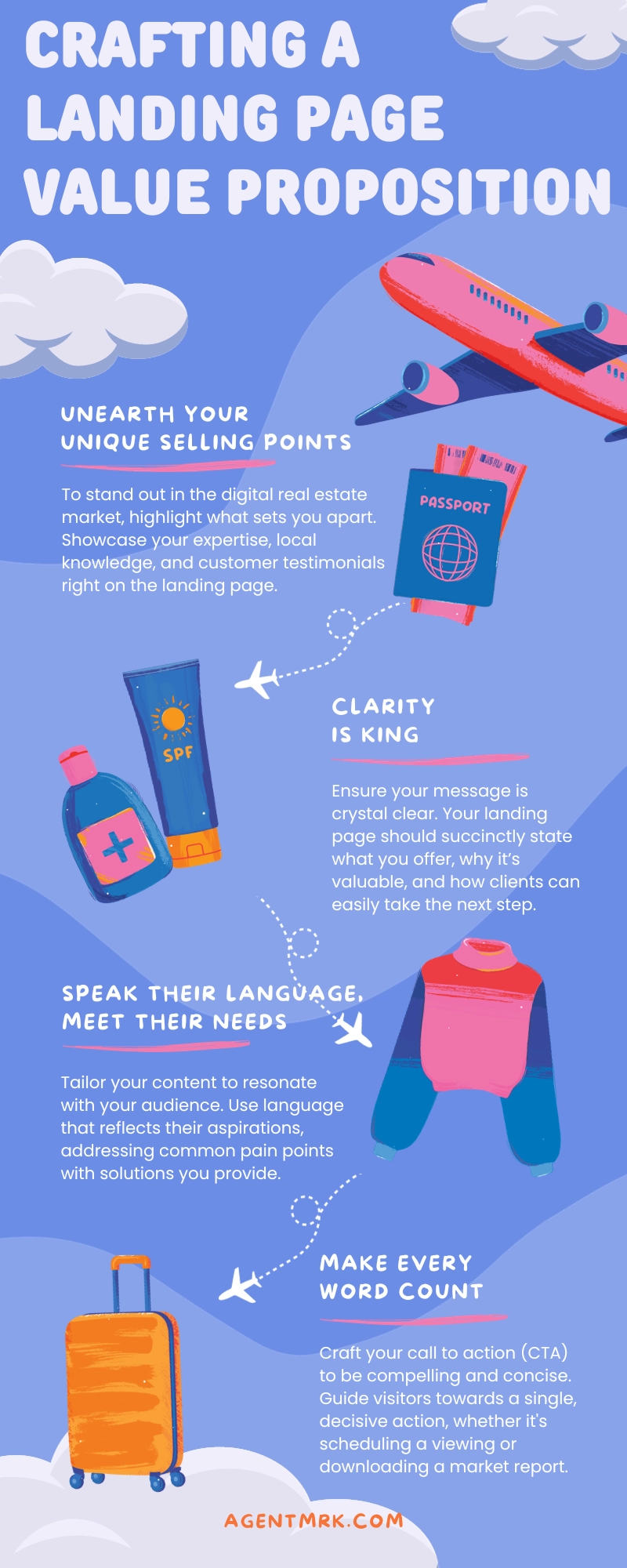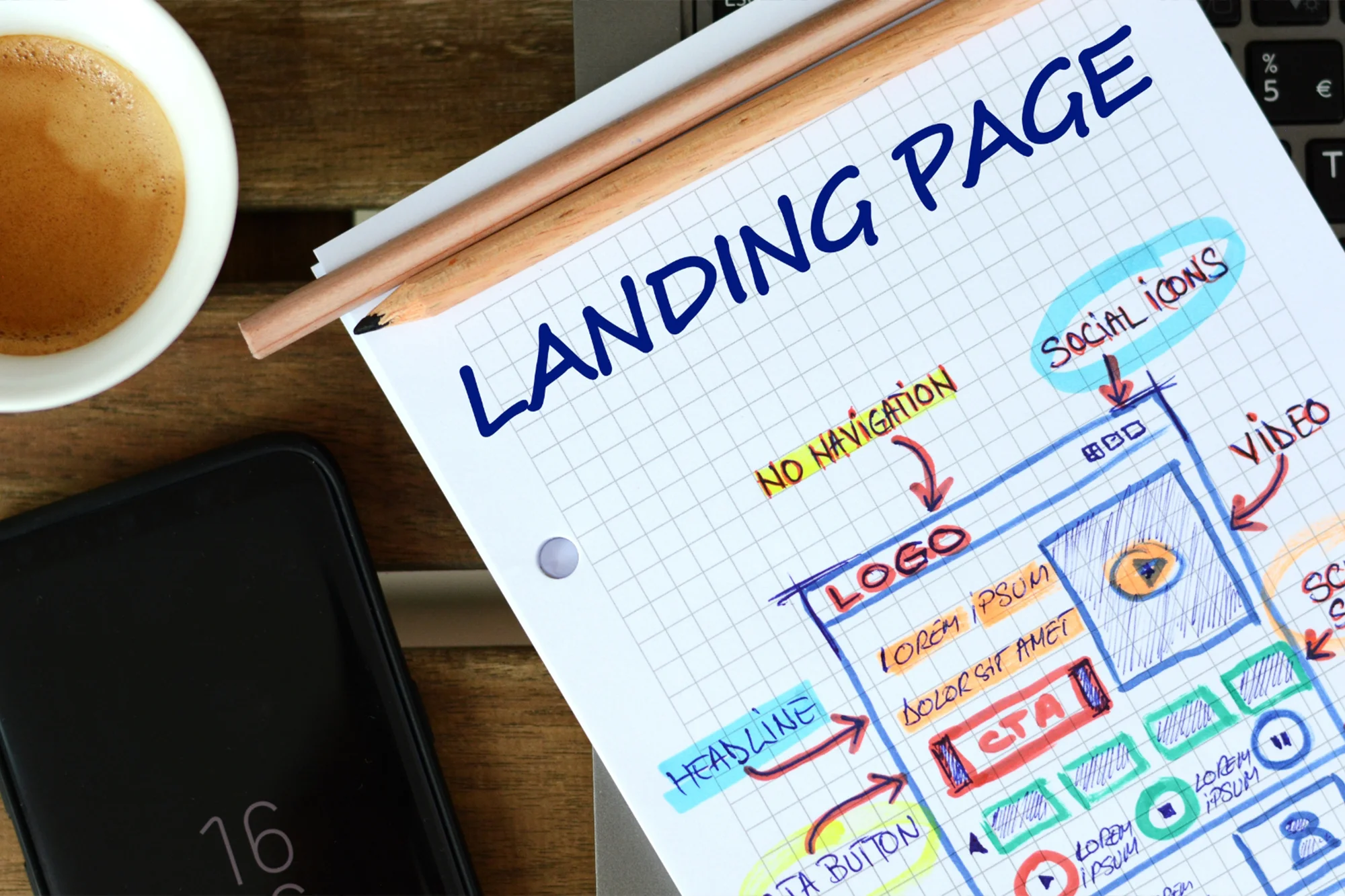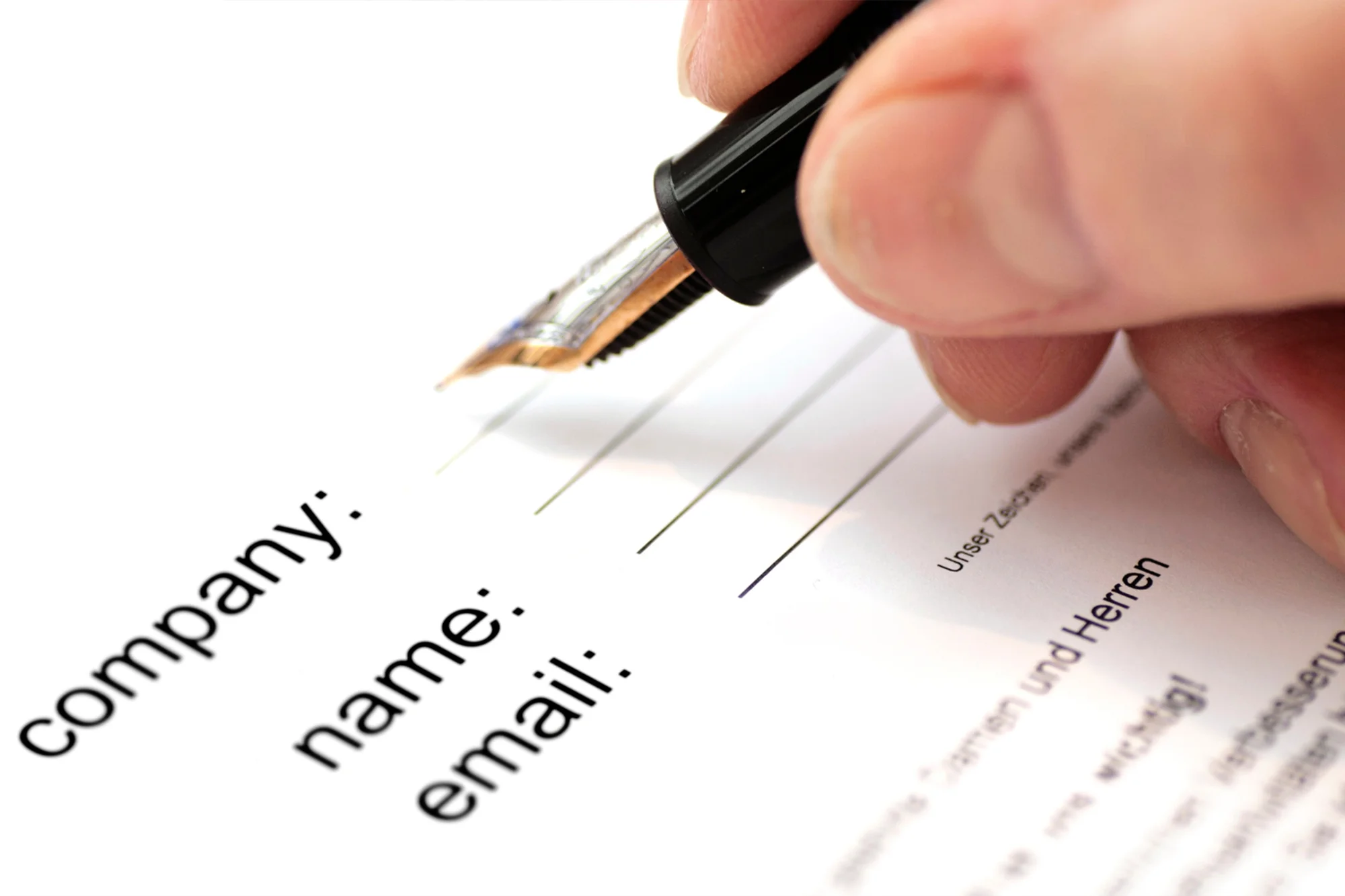Picture this: You’ve just unleashed the most eye-catching, wallet-opening, buzz-generating property listing ad the digital world has ever seen. The clicks are pouring in like coffee at a Monday morning meeting, but there’s a catch – your online visitors are bouncing faster than a rubber ball on concrete. Why? Your landing page is about as inviting as a closed door. Fear not, intrepid real estate marketer! The secret to turning those digital window-shoppers into bona fide leads is not just in the click – it’s in the landing. Let’s dive into the art and science of landing pages that don’t just capture leads, they captivate them.

- 1. The Role of Landing Pages in Real Estate
- 2. Setting Your Landing Page Goals
- 3. Crafting a Clear Value Proposition
- 4. High-Quality Visuals
- 5. Writing Compelling Headlines
- 6. Mobile Optimization is a Must
- 7. Speed Up Your Landing Page
- 8. Incorporating Social Proof
- 9. Simplified Lead Capture Forms
- 10. Crafting a Strong Call to Action (CTA)
- 11. Offer Valuable Content
- 12. A/B Testing – The Key to Continuous Improvement
- 13. Tracking, Analytics, and Data-Driven Decisions
- Touchdown!
- FAQ
1. The Role of Landing Pages in Real Estate
Why Your Landing Page is Your Digital Handshake
First impressions in the real estate cosmos are no longer made with a firm handshake at the doorway. They’re made at the speed of light, with a swift click to your landing page. This is your digital handshake, and trust me, a limp digital grip won’t cut it. Your landing page is not just a standalone web page; it’s the ace in your pocket, the charismatic charmer that can make or break a deal.
Open 24/7: The Always-On Real Estate Agent
Consider your landing page the most tireless member of your team, one that works round-the-clock, across time zones, and even in the quietest hours of the night. It’s there when you’re catching Z’s, ready to greet night owl nest hunters or early bird investors. It’s your digital billboard, storefront, and savvy sales rep, all rolled into one pixel-perfect package.
SEO: The Street Signs Pointing to Your Property
Now, let’s talk location, location, location – but in cyberspace. If a house on the market is hidden behind overgrown bushes and a maze of backstreets, it might as well be invisible. The same goes for your landing page without Search Engine Optimization (SEO). SEO is the street sign that directs traffic to your page, the beacon that guides potential leads through the cluttered digital neighborhood straight to your door.
With the right blend of engaging content, seamless navigation, and an alluring call-to-action (CTA), your landing page can become the ultimate conversion machine. It’s not just about being found; it’s about being remembered, and most importantly, being chosen.
2. Setting Your Landing Page Goals

Chasing Clicks or Courting Clients?
Before we unleash the full potential of your landing page, ask yourself this: What’s the endgame? Knowing the answer is like having the blueprints before building a house. Without it, you’re just stacking bricks. So, what do you want your visitors to do? It’s time to set some serious goals.
PRO TIP
Always align your landing page goals with your broader business strategy. A well-synchronized approach increases ROI.
The Art of Conversion: More Than Just a Numbers Game
Whether it’s enticing prospects to book a consultation, sign up for exclusive listings, or download your insider’s guide to the local market, each goal is a carefully laid stepping stone towards conversion. Your goal isn’t just to up the ante on clicks; it’s to cultivate a community of engaged, interested, and invested clientele.
Measure Twice, Convert Once
Like any savvy contractor, you measure twice and cut once. Similarly, set SMART (Specific, Measurable, Achievable, Relevant, Time-bound) goals for your landing page. This ensures that you’re not shooting in the dark, but aiming with precision at the target – that sweet spot of visitor engagement and action.
With your goals set, let’s put the spotlight on the cornerstone of any successful landing page – the value proposition.
3. Crafting a Clear Value Proposition
Your Digital Elevator Pitch: Make Every Word Count
Your value proposition is your digital elevator pitch. It’s not the time to be shy or mysterious. Within seconds, visitors should know who you are, what you’re offering, and why you’re the best choice in the vast real estate universe.
Unearth Your Unique Selling Points
What makes your service as enticing as a beachfront bungalow? Dig deep. Maybe it’s your unrivaled knowledge of the local market, your bespoke house-hunting services, or your knack for negotiating deals that would make even the toughest clients soft. Pinpoint these gems and display them front and center on your landing page.
Speak Their Language, Meet Their Needs
Speak directly to the heart of your visitors’ desires. Are they looking to nest, invest, or rest? Use language that resonates with your target demographic. A retiree looking for a peaceful lakeside cabin won’t be wooed by the same flashy phrases that would attract a high-flying downtown developer.
PRO TIP
Use empathetic language. Put yourself in the client’s shoes—what’s the burning question they need answered?
Clarity is King
Be crystal clear. Avoid jargon that might confuse or industry speak that could alienate. Your value proposition should be understood in the time it takes for the elevator to reach the next floor.
Now that we’ve laid the foundation with clear goals and a compelling value proposition, your landing page is shaping up to be the go-to destination for prospective buyers and sellers. Stay tuned as we next dive into the specifics of high-quality visuals that don’t just decorate your page, but speak volumes of the value you offer.

4. High-Quality Visuals
A Picture Paints a Thousand Contracts
Imagine walking into an open house where the photos were fuzzy and dim. You’d probably turn on your heel before you even saw the spectacular backyard. This is where high-quality visuals come into play on your landing page. They’re not just pictures or videos; they’re your first showing.
Curate a Visual Feast
Your imagery should be as curated as an art gallery opening. Each visual needs to entice, engage, and echo the quality of your listings. Think about the luscious imagery in a glossy magazine spread. That’s the standard your visuals should aspire to.
The Virtual Tour De Force
Incorporate 360-degree views, virtual tours, and videos that allow visitors to step inside the property from anywhere in the world. This isn’t just about showing spaces; it’s about selling dreams and lifestyles.
Visuals are the hook, but what reels them in? The mighty pen—or in our digital era, the mighty keyboard. Let’s craft headlines that capture hearts.
5. Writing Compelling Headlines

The Marquee of Your Masterpiece
Think of your headline as the marquee on a theatre, promising a performance that’s unmissable. Your headline should grab attention, stir curiosity, and give just enough spotlight to the storyline that viewers can’t help but buy a ticket to the show.
Headlines That Hook
Start with the essentials: location, luxury, lifestyle. Then infuse them with emotional triggers and power words. “Unlock the Door to Your Dream Downtown Loft” beats “Downtown Lofts Available” every time. It’s about creating an irresistible siren call that beckons visitors deeper into your digital abode.
SEO: Your Headline’s Secret Weapon
But let’s not forget our friend SEO. Your headline should be as searchable as it is snappy. Integrating keywords naturally will help your landing page become the darling of search engines, driving traffic as effectively as roadside billboards.
PRO TIP
Use tools like CoSchedule’s Headline Analyzer to gauge the impact of your headline before publishing.
Now that we’ve visualized success and headlined our way into the hearts of our visitors, it’s time to ensure the rest of the content on the landing page is just as arresting. The images have opened the door, the headlines have welcomed them in, and now it’s up to the body of your landing page to close the deal.
6. Mobile Optimization is a Must
Swipe Right on Functionality
In an age where love might start with a swipe right, don’t let a swipe up be the end of your relationship with a potential client. Mobile optimization ensures your landing page makes a great impression across all devices, especially on the smartphones that nearly everyone carries like a lifeline.
The Handheld Open House
Your virtual open house needs to be as navigable on a phone as it is on a desktop. No one should have to pinch, zoom, or squint to see the fine details of your high-definition property photos or the sleek lines of your copy. Think of it as feng shui for the digital age: everything harmoniously aligned for peace, prosperity, and quick loading times on small screens.
Responsive Design: The One Size Fits All Approach
A responsive design ensures your page looks impeccable on any device, adjusting like a seasoned chameleon to whatever screen it’s viewed on. The goal? A seamless experience whether they’re thumb-scrolling in a cafe or click-tracking with a mouse.
With mobile readiness in check, let’s shift gears to the fast lane because speed isn’t just for the autobahn; it’s for your landing page too.
7. Speed Up Your Landing Page

The Need for Speed: Digital Edition
In a world where a loading bar is more dreaded than rush-hour traffic, your landing page’s speed can mean the difference between a lead and a letdown. If your page takes more than a few seconds to load, potential clients will bail faster than a shrewd investor on a bad deal.
Don’t Let Lag Lose Leads
Every second counts. Speed is a silent salesman; it doesn’t talk, but it converts. Optimizing images, minifying code, and leveraging browser caching are just the starts. You need to ensure that the backend of your site is as spruced up as the front.
Test, Tweak, Triumph
Use tools like Google’s PageSpeed Insights to test your page’s performance and follow its recommendations to enhance speed. With a lightning-fast landing page, you’ll keep visitors engaged, not enraged by loading lags.
A swift site not only pleases visitors but also ranks better on search engines. It’s like being the first to spot a ‘For Sale’ sign on a prime piece of property. Speed is your secret to getting there first, and staying there.
8. Incorporating Social Proof
The Neighbors’ Nod of Approval
Just as a glowing recommendation from a neighbor can seal the deal on a house sale, social proof on your landing page can be the reassuring nod that converts a skeptic into a believer. Let’s face it, in the real estate world, reputation is the cornerstone of trust.
Testimonials: Your Digital Applause
Incorporate testimonials like you would crown molding in a stately manor – with intention and finesse. A carousel of praise from past clients, local celebrities, or industry experts can do more than any sales pitch. It’s not bragging if someone else says it, right?
PRO TIP
Tap into the power of storytelling by framing your client testimonials as stories to create emotional connections with prospects.
Showcase Your Wins
Don’t be shy; display those awards, certifications, and recognitions with pride. They are the ribbons on your digital uniform, showing you’ve been in the trenches and came out victorious.
Ratings and Reviews: The 5-Star Strategy
A high rating can be the five-star gourmet meal of content – utterly satisfying. Embed real-time review feeds from sites like Zillow or Realtor.com to display current and credible accolades.
With trust built through social proof, now it’s time to make the connection. Next up, we’re making sure that your lead capture forms are as welcoming and as easy to navigate as a sunny, open-concept kitchen.
9. Simplified Lead Capture Forms

The Front Porch Welcome
Think of your lead capture form as the front porch of your digital home. It should be inviting, not intimidating. The fewer barriers to entry, the better. You want your visitors to feel like the door is open, not locked behind a labyrinth of fields and checkboxes.
Ask Only What You Need
Every question you ask on a form is like a hurdle in a steeplechase: necessary, but there shouldn’t be one too many. Request only what’s essential to follow up—usually a name, email, and maybe a phone number. Keep it simple; keep it sweet.
The Path of Least Resistance
Opt for a minimalist approach, reducing friction and making the process of leaving their contact information as effortless as falling in love with their dream home. Autofill functionalities, single sign-on options, and a clear call to action (CTA) are the welcome mat to your form.
Privacy, Please
In today’s digital landscape, a nod to privacy goes a long way. A simple reassurance that their information won’t be shared with third-party sites is like a fence around their yard: It gives peace of mind.
With social proof solidifying your reputation and your lead capture forms honed to perfection, you’re on the verge of a breakthrough in landing page optimization. Stay with me as we gear up to the next step—A/B testing, the key to landing page success.
10. Crafting a Strong Call to Action (CTA)
Seal the Deal with a Single Click
The call to action is your digital handshake – the point where introductions are over, and business begins. It’s your “Please Sign Here” sticker on the last page of the contract. A powerful CTA doesn’t just ask; it compels. And in real estate, compelling is the key to closing.
The Art of Persuasion
Your CTA should be as irresistible as a dream property listed below market value. Use commanding, action-oriented language. Instead of the overused “Submit,” why not “Start Your Dream Home Journey” or “Claim Your Exclusive Viewing”?
Stand Out, Don’t Blend In
Ensure your CTA button stands out like a manicured lawn in a row of untended gardens. Make it pop with contrasting colors and ample white space. Think of it as the red front door in a sea of beige: impossible to ignore.
PRO TIP
Leverage the power of color psychology in your CTA buttons; for instance, green conveys growth and success, potentially increasing click-through rates.
Consistency Leads to Clicks
Keep your message consistent from headline to CTA. If you’ve promised a tour of luxury condos, your CTA should be the ribbon-cutting to that experience. A mismatched CTA is like showing up to a black-tie event in beachwear – jarring and confusing.
With a CTA that beckons as clearly as a ‘Home Sweet Home’ sign, let’s pivot to what’s behind the door: content that delivers value as solid as a well-built foundation.
11. Offer Valuable Content

Become the Go-To Resource
In real estate, it’s not just location, location, location—it’s also information, information, information. Your landing page should offer content that’s as valuable as a newly renovated kitchen in a buyer’s market.
Educate, Don’t Just Sell
Create content that positions you as the sage of the housing market. Whether it’s a free e-book on “Navigating Your First Home Purchase” or an infographic on “Home Staging Tips to Sell Your Home Faster,” make your content so useful that they can’t help but reach out.
Lead Magnets that Attract
Think of your value-rich content as a lead magnet. It should attract potential clients in a way that benefits them just by being in its presence, like a park-side setting increases property allure.
Gate Content Wisely
If you gate content (require information before access is granted), ensure it’s worth the trade. A visitor will happily exchange their contact details for a market analysis report, much like they’d trade their current home for their dream house.
12. A/B Testing – The Key to Continuous Improvement

Tweak and Triumph
Welcome to the world of A/B testing, where the difference between good and great is discovered in the duel of dual versions. Like an open house showdown, this is where two versions of your landing page go head-to-head to charm the socks off your visitors.
The Digital Taste Test
Imagine you’re offering two flavors of cookies at your open house: will it be classic chocolate chip or trendy salted caramel? Similarly, A/B testing lets you serve up two versions of your CTA, headline, or even the entire landing page to see which one gets gobbled up more.
PRO TIP
Experiment with directional cues such as arrows or images of people looking towards your CTA, subtly guiding visitors’ attention to take action.
Split Testing for Success
It’s simple: half your visitors see version A, the other half, version B. Which one leads to more sign-ups or inquiries? That’s your winner. It’s the difference between “For Sale” and “Sold.”
Embrace the Experiment
Don’t fear this process. Embrace the experimentation. Even a ‘failed’ test is a win brimming with insights. Remember, every tweak is a step towards perfection.
Now, with the nitty-gritty of A/B testing handled, let’s talk about what happens when the rubber meets the road: tracking, analytics, and making data-driven decisions.
13. Tracking, Analytics, and Data-Driven Decisions
Beyond the Open House Sign-In Sheet
In the bygone days, a sign-in sheet at your open house was how you gauged interest. Now, analytics lets you track every digital footprint on your landing page, offering insights as deep as a well-staged walk-in closet.
The Metrics That Matter
From bounce rates to conversion rates, the numbers tell a story. They show where potential clients linger and where they leap. Tools like Google Analytics become your new best friends, helping you read the room, digitally speaking.
Data-Driven Strategy
Armed with data, you can pivot like a pro, making decisions that are as sound as a steel beam in a skyscraper. This isn’t guesswork; it’s strategy with the precision of a well-crafted floor plan.
The Feedback Loop
Make your data work for you. Let it feed back into your A/B testing, content creation, and CTA placement. It’s the ecosystem of digital marketing: always growing, always improving.
Touchdown!
You’ve journeyed through the digital landscape of landing page optimization like a seasoned agent through a bustling open house. From crafting a call to action that’s as compelling as a beachfront view, to providing content more valuable than a penthouse suite, your foundation is set. Now, it’s time to take these strategies, these digital tools of the trade, and craft a space that turns casual visitors into lifelong neighbors.
Remember, your landing page is more than just a slice of internet real estate; it’s a home for your expertise, a gallery for your listings, and a welcoming mat for your future clients. It’s where first impressions become lasting connections.
KEY TAKEAWAYS
- Your landing page is your online home’s first impression—make it count.
- Tailored content and CTAs are your magnetic duo.
- Data and creativity should go hand-in-hand; one fuels the other.
- A/B testing is the magic wand of continuous improvement.
- Digital success in real estate rests on user experience.
- Mobile optimization isn’t just good—it’s mandatory.
- Every digital footstep is a clue—track, analyze, act.
- Optimize with intention, align with purpose, and watch your business thrive.
FAQ
What if my target audience isn’t tech-savvy?
Keep your landing page simple, user-friendly, and intuitive. Use familiar language and offer multiple ways for them to get in touch with you directly.
Can I use my landing page for multiple real estate campaigns at the same time?
While possible, it’s more effective to create dedicated landing pages for each campaign to tailor the experience and message to each unique audience and set of property listings.
What’s the best way to personalize landing pages for return visitors?
Leverage cookies and tracking tools to display personalized greetings or content based on the visitor’s previous interactions, such as suggesting new listings in the areas they’ve shown interest in.
How often should I update the content on my landing page?
Content should be refreshed regularly to reflect the most current listings, market trends, and relevant advice. At a minimum, review and update your landing page content monthly.
How do I ensure my landing page is accessible to all potential clients, including those with disabilities?
Ensure compliance with the Web Content Accessibility Guidelines (WCAG) by using alt text for images, providing text transcripts for video content, and ensuring your site can be navigated with a keyboard.